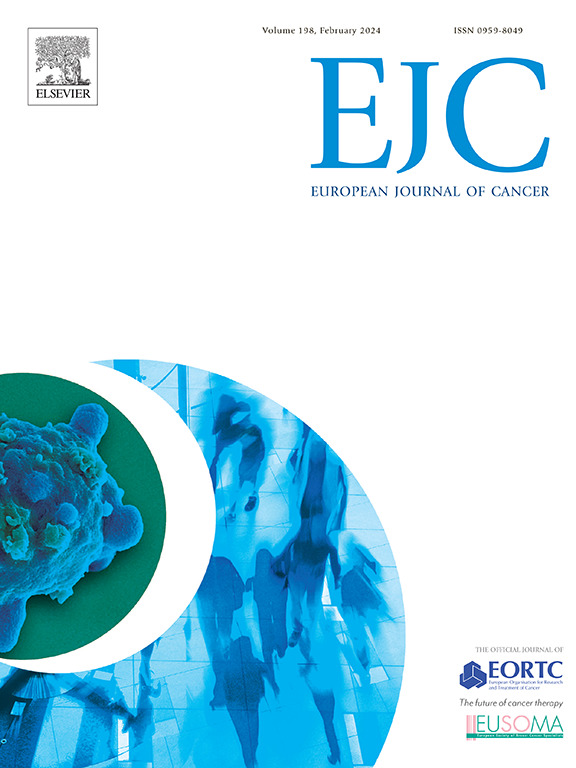Rucaparib for maintenance treatment of platinum-sensitive, recurrent ovarian carcinoma: Final results of the phase 3, randomized, placebo-controlled ARIEL3 trial
IF 7.1
1区 医学
Q1 ONCOLOGY
引用次数: 0
Abstract
Background
In ARIEL3, rucaparib maintenance significantly improved progression-free survival (PFS; primary endpoint) and long-term follow-up (LTFU) outcomes (including PFS2: time to disease progression on subsequent therapy or death) versus placebo in patients with recurrent, platinum-sensitive ovarian cancer. Here we report the final analysis of overall survival (OS; key secondary endpoint), LTFU outcomes, and safety.
Methods
OS and updated LTFU efficacy outcomes were analyzed (data cutoff date: April 4, 2022) across three nested populations (BRCA-mutated, homologous recombination deficient [HRD], and intention to treat [ITT]).
Results
Patients were randomized 2:1 to rucaparib (600 mg BID; n = 375) or placebo (n = 189). Median follow-up was 77.0 months. 168 patients in the placebo arm received subsequent treatment; of these, 77 (46 %) received a poly(ADP-ribose) polymerase inhibitor–containing treatment. Median OS from randomization post chemotherapy for rucaparib vs placebo was 45.9 vs 47.8 months (HR 0.83, 95 % CI 0.58–1.19) for the BRCA-mutated population; no OS benefit was found with rucaparib in the HRD and ITT populations. Median PFS2 for rucaparib vs placebo was 26.1 vs 18.4 months (HR 0.67, 95 % CI 0.48–0.94) for the BRCA-mutated population. Rucaparib numerically improved PFS2 and other LTFU outcomes versus placebo in the HRD and ITT populations. Safety was consistent with prior reports; myelodysplastic syndrome and/or acute myeloid leukemia occurred in 4 % and 3 % of patients in the rucaparib and placebo arms, respectively.
Conclusions
OS was similar between treatment arms. PFS benefit with rucaparib was maintained through the subsequent therapy line. These data support rucaparib as maintenance treatment for recurrent ovarian carcinoma.
鲁卡帕尼用于铂敏感复发性卵巢癌的维持治疗:3期随机、安慰剂对照ARIEL3试验的最终结果
在ARIEL3中,鲁卡帕尼维持显著改善无进展生存期(PFS;主要终点)和长期随访(LTFU)结果(包括PFS2:在后续治疗中疾病进展或死亡的时间)与安慰剂相比,复发性铂敏感卵巢癌患者。在此,我们报告总生存期(OS;关键次要终点)、LTFU结局和安全性。方法分析了三个嵌套人群(brca突变,同源重组缺陷[HRD]和意向治疗[ITT])的sos和更新的LTFU疗效结果(数据截止日期:2022年4月4日)。结果患者按2:1随机分配给鲁卡帕尼(600 mg BID;N = 375)或安慰剂(N = 189)。中位随访时间为77.0个月。安慰剂组的168名患者接受了后续治疗;其中,77例(46% %)接受了含有聚(adp -核糖)聚合酶抑制剂的治疗。brca突变人群化疗后随机化鲁卡帕尼vs安慰剂的中位OS为45.9个月vs 47.8个月(HR 0.83, 95 % CI 0.58-1.19);未发现鲁卡帕尼在HRD和ITT人群中的OS获益。brca突变人群中,rucaparib和安慰剂的中位PFS2分别为26.1个月和18.4个月(HR 0.67, 95 % CI 0.48-0.94)。在HRD和ITT人群中,与安慰剂相比,鲁卡帕尼在数值上改善了PFS2和其他LTFU结果。安全性与先前的报告一致;在鲁卡帕尼组和安慰剂组中,骨髓增生异常综合征和/或急性髓系白血病分别发生在4 %和3 %的患者中。结论各治疗组间sos相似。在随后的治疗中,鲁卡帕尼的PFS益处得以维持。这些数据支持rucaparib作为复发性卵巢癌的维持治疗。
本文章由计算机程序翻译,如有差异,请以英文原文为准。
求助全文
约1分钟内获得全文
求助全文
来源期刊

European Journal of Cancer
医学-肿瘤学
CiteScore
11.50
自引率
4.80%
发文量
953
审稿时长
23 days
期刊介绍:
The European Journal of Cancer (EJC) serves as a comprehensive platform integrating preclinical, digital, translational, and clinical research across the spectrum of cancer. From epidemiology, carcinogenesis, and biology to groundbreaking innovations in cancer treatment and patient care, the journal covers a wide array of topics. We publish original research, reviews, previews, editorial comments, and correspondence, fostering dialogue and advancement in the fight against cancer. Join us in our mission to drive progress and improve outcomes in cancer research and patient care.
 求助内容:
求助内容: 应助结果提醒方式:
应助结果提醒方式:


